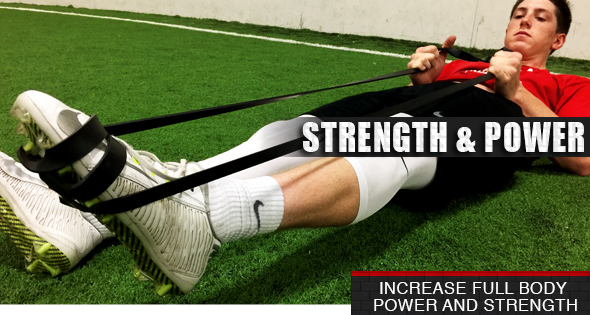Hamstring Anatomy
The hamstrings are composed of three muscles that control knee flexion (bringing the heel to the butt) and hip extension (or a pushing forward of the hips). The hamstring curl is a great example of flexion at the knee. Whether from the seated, standing, or prone position the hamstring curl is one of the best hamstring exercises due to the angles created throughout the movement. Placing the tension of the hamstring curl on the heel or low on the back of the ankle creates more distance between the point of resistance and the muscles performing athletic movement. This allows athletes to use the hamstring curl to challenge the hamstring muscles in a long range of motion.
However, the hamstring anatomy also performs hip extension that is a much shorter, but still a very important movement. Hip extension is what allows athletes to successfully complete some of the other best hamstring exercises like stiff legged deadlifts (or RDL’s), traditional deadllift, glute raises, and squats.
Best Hamstring Exercises For Explosiveness
The hamstring anatomy is composed of primarily fast twitch muscles. This makes hip extension an important part of explosive movements, as well as the strength movements mentioned above. When an athlete performs any kind of jumping exercise they should not jump with hips straight or bent. Athletes should instead use great hip extension to help elevate their jumps higher off the ground. As athletes load up for their jump they should limit the amount of flexion at their knees and should instead flex the hips by bringing the chest lower at the bottom of the jump. Then as athletes explosively jump up they should think about “getting tall” and fully extending their hips at the top of the jump.
Using resistance equipment like the Reactive Stretch Cord, Kbands Leg Resistance Bands, or Ballistic Loop Bands will force athletes to generate greater hip extension through their jumps. This will lead to higher and more explosive jumps and movements during training and competition. Go to the Training Section to learn about training drills that incorporate some kind of resisted jump.
Ballistic Bands Reverse Hamstring Curl
The key to incorporating the hamstrings into explosive movements is activating and strengthening the muscles of the hamstring. The Ballistic Bands Reverse Hamstring Curl is one of the best hamstring exercises to induce massive amounts of muscle activation. Using the Ballistic Bands Reverse Hamstring Curl to challenge the hamstring muscles in an eccentric movement allows the muscle to handle large amounts of tension while the athlete focuses on squeezing the muscle.
To perform the Ballistic Bands Reverse Hamstring Curl athletes will need 2-3 different levels of Ballistic Bands and a partner. The Ballistic Bands come in several different levels of resistance. Go to the Shop Section to view all the different levels of resistance. Athletes will lie on their stomachs and wrap the Ballistic Bands around the back of their ankle or lower calf area of one of their legs. The amount of resistance for the Ballistic Bands Reverse Hamstring Curl should be great, acting like a belt. Partners will kneel behind the athlete, grab the opposite end of the Ballistic Band, and manually resist the hamstring curl movement. Athletes will start the Ballistic Bands Reverse Hamstring Curl by raising their heel until their leg is at a 90-degree angle.
At this point their partner will pull on the Ballistic Band and begin to pull the athletes foot toward the ground. Athletes will focus on squeezing the hamstring as they perform a hamstring curl and resist the Ballistic Band until the foot is 3-4 inches from the ground. At this point the partner will lessen the tension to a point the athlete can perform a traditional, resisted hamstring curl back to their starting position. Athletes will perform 3 sets of 8-10 repetitions on each leg, taking 90 seconds to 2 minutes of rest between sets. After all single sets of the Ballistic Bands Reverse Hamstring Curls have been completed athletes will place the Ballistic Band around both feet and perform 3 sets of 8-10 repetitions at a faster pace than the single legged hamstring curl. Athletes and partners will actively work to increase the speed of the Ballistic Bands Reverse Hamstring Curl by moving to a lighter amount of resistance and decreasing the amount of tension felt throughout the hamstring curl movement.
Maximize Results With Good Form And Execution During The Ballistic Bands Reverse Hamstring Curl
While athletes are curling their leg toward and away from their butt area they need to maintain all of the tension in the muscles of the hamstring. In order to maintain the maximum amount of tension throughout the entire hamstring curl athletes will need to maintain both hips flat on the ground. If the athlete begins to flex at the hips they will begin recruiting additional hip flexor muscles to complete the hamstring curl movement. This flexion at the hip will not only reduce tension to the hamstring muscles but will also cause over tightness in several important stabilizing hip flexor muscles. Over tightness in these muscles can lead to hip pain and possible injuries. To learn how to stretch these hip flexor muscles athletes can go to the Recovery Section and explore the Quad Stretching and Groin Stretching recovery exercises with the Recovery Foam Roller. If assisting partners begin to see too much flexion at the hip or twisting of the body to complete the hamstring curl movement stop and alert the athlete. Consider moving to a lighter level of Ballistic Bands if the athlete cannot complete the hamstring curl movement with good form.
Athletes and coaches should pair the Ballistic Bands Reverse Hamstring Curl with additional upper body and core strengthening exercises. Maintaining proper strength in all parts of the body will allow athletes to be faster, stronger, and more explosive during training and competition.

